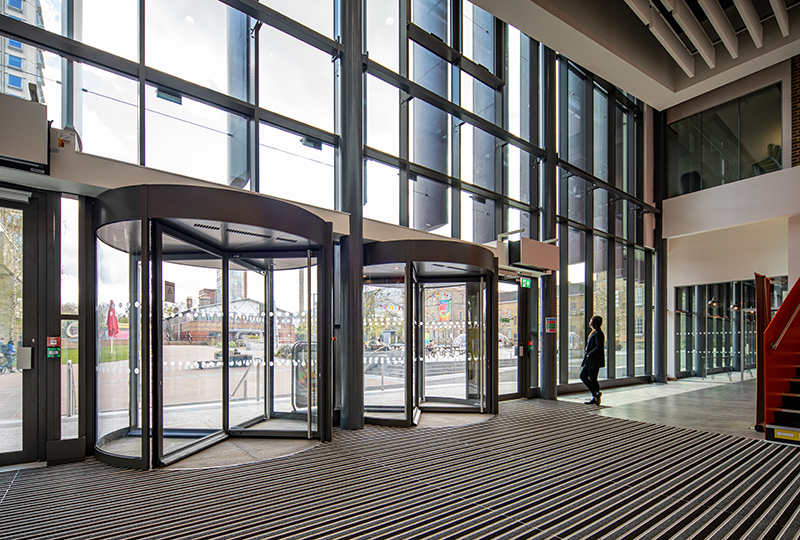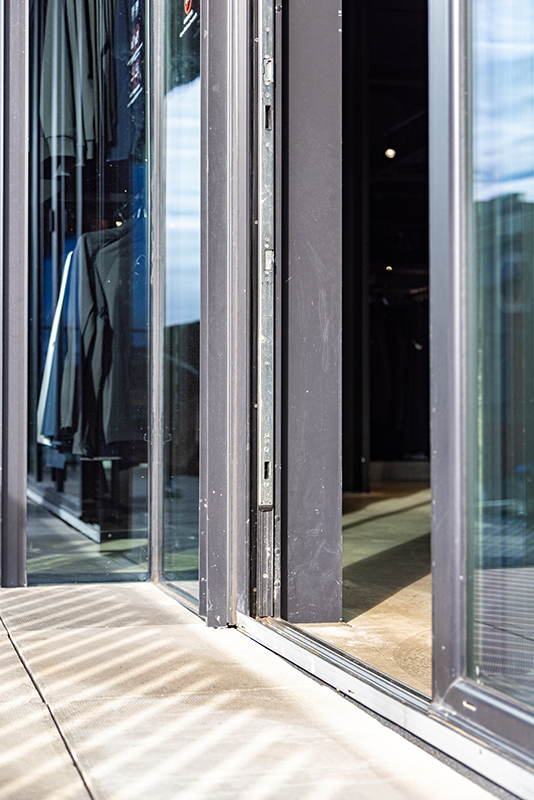
Commercial door specification is rarely straightforward. The need to balance design aspirations with stringent safety, security and accessibility requirements can present a number of challenges, especially when multiple door types are needed on the same project. Kenny McMenemy, Senior Architectural Systems’ architectural advisor for Scotland, discusses why sourcing different commercial door systems from a single supplier doesn’t just offer a logistical advantage but can offer tangible benefits across the full building envelope.
Why choice matters
In sectors as diverse as education, healthcare, retail and industrial, commercial door systems are required to perform multiple functions. They may need to welcome high footfall, enable step-free access, provide secure entry points, or maintain visual continuity with adjacent façades. Crucially, all of these functions may be needed within a single building.
This is where flexibility of choice becomes essential. The ability to specify a mix of commercial door types, from automatic entrances to robust manual doors, low-threshold options and sleek bi-folds and sliding doors, means that each area of the building can be tailored to its specific use without compromising on aesthetics or performance.
The advantages of aluminium
Aluminium has become the material of choice for commercial door systems, and for good reason. Its inherent strength allows for wider and taller openings, supporting larger glazing panels that offer slim sightlines and greater visual transparency which are ideal for modern buildings that prioritise the use of natural light.
In terms of durability and longevity, aluminium is hard to beat and as it is resistant to corrosion and weathering, it is well-suited to Scotland’s often challenging climate. Aluminium systems also score highly from a sustainability perspective and like all of the products within our own range, are fully recyclable.
Critically, aluminium door systems now offer excellent thermal performance. With the increased focus on energy efficiency in Scotland, especially under Section 6 (Energy) of the Scottish Building Standards, low U-values and high insulation performance are no longer optional extras. Aluminium systems can meet and exceed these requirements, helping support broader sustainability goals and improving BREEAM ratings.

Accessibility and compliance
The choice of commercial doors also plays a vital role in creating buildings that are accessible to all users. Considerations include door width, opening mechanism, threshold height and visibility. Large glazed panels, made possible by the inherent strength of the aluminium frame, can help aid navigation, particularly when combined with contrasting frame colours and accessible ironmongery.
Automatic operation can also assist those with limited mobility, and the specification of low thresholds and anti-finger trap stile, especially in schools and healthcare facilities, also demonstrates best practice in these sectors.
Achieving these performance requirements can be a challenge and collaboration with the supply chain is invaluable. Engaging with a system manufacturer early in the process can help contractors ensure that specifications align with both national standards and building-specific needs. The use of BIM further streamlines this process, improving coordination and supporting compliance from the outset.

The case for a single supplier
Where multiple door types are required within the same project, particularly when they form part of a larger fenestration package of windows and curtain walling, working with a single, experienced supplier can offer major benefits. Not only does it reduce the risk of incompatibility between different systems, which can affect performance and cause installation delays, but it provides a single point of accountability. Essentially, simplifying warranties and aftercare by keeping everything with one supplier.
The use of complementary aluminium systems can also create a more unified aesthetic across different elevations and entrances. Just as importantly, a sole supplier can advise on hardware, handles, thresholds and other fixtures and fittings. This can help ensure that all doors, whether these are used as high-traffic entrances or secondary access points, are appropriately specified.
Bringing performance and design together
The best commercial door systems strike a balance between form and function. Some will be tasked with creating a strong first impression, others with providing secure emergency exits or withstanding frequent, daily use in busy high-traffic areas. The varied demands of these spaces mean that no single door type will meet every need.
Rather than compromising on design or performance, main contractors should look for a supplier that offers breadth of range and depth of technical support. A partner with this capability can help navigate the full range of design considerations, from thermal efficiency and structural loading to regulatory compliance and future maintenance.








